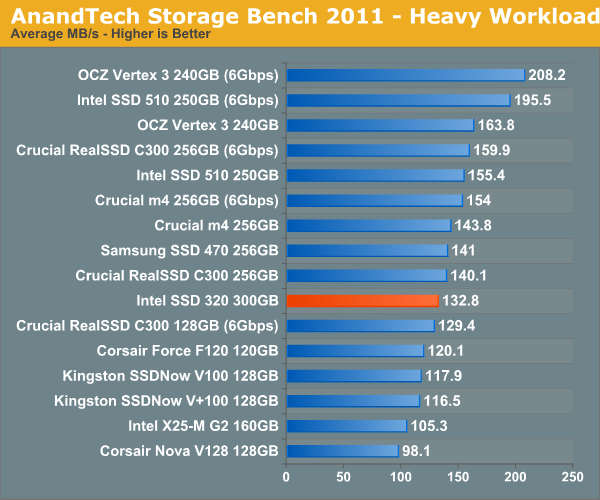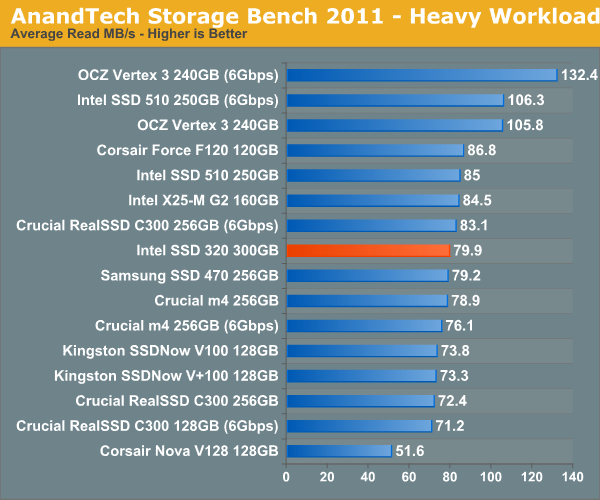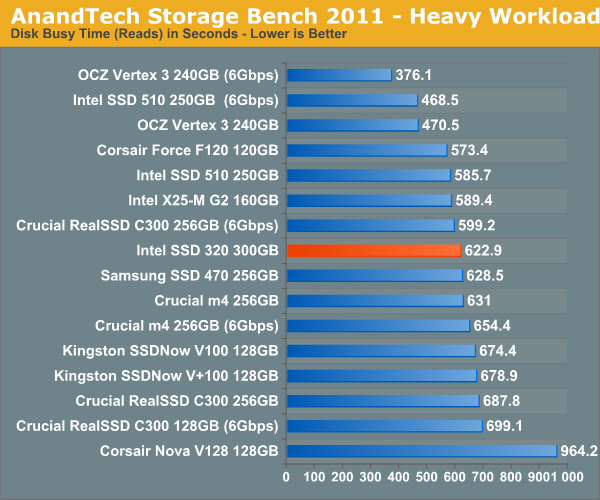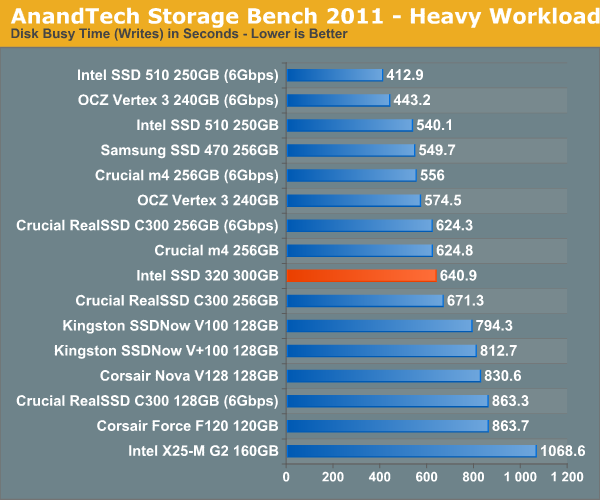The Intel SSD 320 Review: 25nm G3 is Finally Here
by Anand Lal Shimpi on March 28, 2011 11:08 AM EST- Posted in
- IT Computing
- Storage
- SSDs
- Intel
- Intel SSD 320
AnandTech Storage Bench 2011: Much Heavier
I didn't expect to have to debut this so soon, but I've been working on updated benchmarks for 2011. Last year we introduced our AnandTech Storage Bench, a suite of benchmarks that took traces of real OS/application usage and played them back in a repeatable manner. I assembled the traces myself out of frustration with the majority of what we have today in terms of SSD benchmarks.
Although the AnandTech Storage Bench tests did a good job of characterizing SSD performance, they weren't stressful enough. All of the tests performed less than 10GB of reads/writes and typically involved only 4GB of writes specifically. That's not even enough exceed the spare area on most SSDs. Most canned SSD benchmarks don't even come close to writing a single gigabyte of data, but that doesn't mean that simply writing 4GB is acceptable.
Originally I kept the benchmarks short enough that they wouldn't be a burden to run (~30 minutes) but long enough that they were representative of what a power user might do with their system.
Not too long ago I tweeted that I had created what I referred to as the Mother of All SSD Benchmarks (MOASB). Rather than only writing 4GB of data to the drive, this benchmark writes 106.32GB. It's the load you'd put on a drive after nearly two weeks of constant usage. And it takes a *long* time to run.
I'll be sharing the full details of the benchmark in some upcoming SSD articles but here are some details:
1) The MOASB, officially called AnandTech Storage Bench 2011 - Heavy Workload, mainly focuses on the times when your I/O activity is the highest. There is a lot of downloading and application installing that happens during the course of this test. My thinking was that it's during application installs, file copies, downloading and multitasking with all of this that you can really notice performance differences between drives.
2) I tried to cover as many bases as possible with the software I incorporated into this test. There's a lot of photo editing in Photoshop, HTML editing in Dreamweaver, web browsing, game playing/level loading (Starcraft II & WoW are both a part of the test) as well as general use stuff (application installing, virus scanning). I included a large amount of email downloading, document creation and editing as well. To top it all off I even use Visual Studio 2008 to build Chromium during the test.
Many of you have asked for a better way to really characterize performance. Simply looking at IOPS doesn't really say much. As a result I'm going to be presenting Storage Bench 2011 data in a slightly different way. We'll have performance represented as Average MB/s, with higher numbers being better. At the same time I'll be reporting how long the SSD was busy while running this test. These disk busy graphs will show you exactly how much time was shaved off by using a faster drive vs. a slower one during the course of this test. Finally, I will also break out performance into reads, writes and combined. The reason I do this is to help balance out the fact that this test is unusually write intensive, which can often hide the benefits of a drive with good read performance.
There's also a new light workload for 2011. This is a far more reasonable, typical every day use case benchmark. Lots of web browsing, photo editing (but with a greater focus on photo consumption), video playback as well as some application installs and gaming. This test isn't nearly as write intensive as the MOASB but it's still multiple times more write intensive than what we were running last year.
As always I don't believe that these two benchmarks alone are enough to characterize the performance of a drive, but hopefully along with the rest of our tests they will help provide a better idea.
The testbed for Storage Bench 2011 has changed as well. We're now using a Sandy Bridge platform with full 6Gbps support for these tests. All of the older tests are still run on our X58 platform.
AnandTech Storage Bench 2011 - Heavy Workload
We'll start out by looking at average data rate throughout our new heavy workload test:

Overall performance is decidedly last generation. The 320 is within striking distance of the 510 but is slower overall in our heavy workload test.
The breakdown of reads vs. writes tells us more of what's going on:


The next three charts just represent the same data, but in a different manner. Instead of looking at average data rate, we're looking at how long the disk was busy for during this entire test. Note that disk busy time excludes any and all idles, this is just how long the SSD was busy doing something:













194 Comments
View All Comments
NandFlashGuy - Monday, March 28, 2011 - link
Actual data shows that Intel's G2 SSD Reliability is already ahead of mechanical drives:Here's a paper at the 1997 FAST conference discussing actual hard drive failure rates:
http://www.cs.toronto.edu/~bianca/papers/fast07.pd...
A link to the French e-tailer return rate data showing Intel SSDs better than mechanical drives:
http://www.hardware.fr/articles/810-6/taux-pannes-...
A good talk discussing SSD failure rates and mechanisms:
http://intelstudios.edgesuite.net/idf/2010/sf/aep/...
Have any real data to support your claim?
NandFlashGuy - Monday, March 28, 2011 - link
Correcxtion. The FAST paper was from 2007.nonzenze - Monday, March 28, 2011 - link
We were promised Vertex 3 end of March. Didn't happen. At least the Intel 510s are on Newegg ... This review has no mention at all of availability, which I take to be a terrible sign that we won't actually see these in time.Meanwhile it's utterly impossible to plan a build for a new machine with a next-gen SSD because I have no idea when I'll actually be able to order and receive one!
Soft launches suck!
turbodreams - Monday, March 28, 2011 - link
You write "The AS-SSD sequential benchmark takes place at a very high queue depth of 32". This is not correct, as it takes place at QD 1. I asked the author of the benchmark about this, *only* the 4K-64 test uses a higher QD of 64.Anand Lal Shimpi - Monday, March 28, 2011 - link
That's very odd. Perfmon reports a queue depth of 1 however one of our internal monitoring tools indicates a queue depth of 32. I will remove the reference but I'm curious to see what's going on here.Take care,
Anand
WintersEdge - Monday, March 28, 2011 - link
I'm confused. The benchmarks show results for the Crucial M4. Where is the full review for that drive? Did I miss something? Thanks.Shadowmaster625 - Monday, March 28, 2011 - link
$160 for a 74GB SSD? And it is just as slow as the last generation? They are absolutely out of their freakin minds. They're gouging the hell out of their trusting victims. I wont even comment on how awful the 40GB version is, for $90. LOL I just bought an Agility 2 for $90.Chloiber - Tuesday, March 29, 2011 - link
And how happy are you with 35MB/s seq. Write and less than 200 seq. Read?erple2 - Monday, March 28, 2011 - link
What? So you did a hack that Apple doesn't fully support, and expect that if it implodes, you get to complain about it?Really?
I'm disappointed in you, Brian.
overzealot - Tuesday, March 29, 2011 - link
It was a joke. Lighten up.